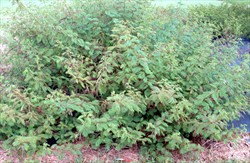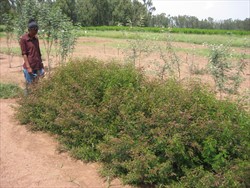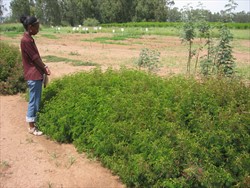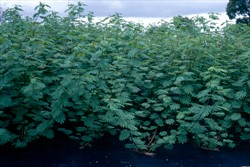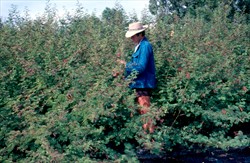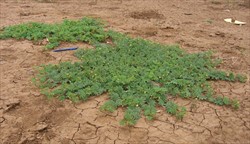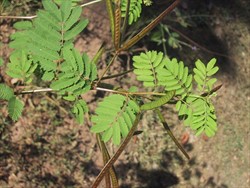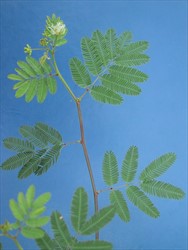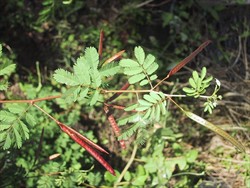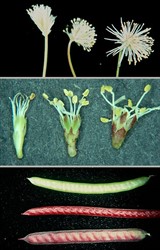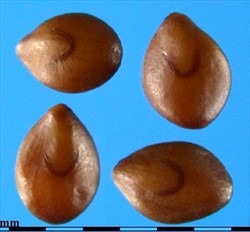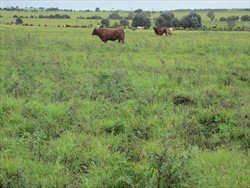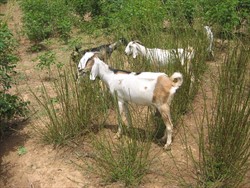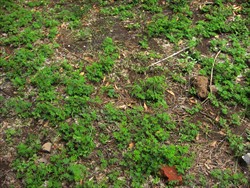Desmanthus leptophyllus
Tropical Forages
Desmanthus leptophyllus Kunth
Note: Turner (1950) regarded Desmanthus virgatus as [1] [2] [3] an all-encompassing species, comprising D. virgatus [1] [2] [3], D. pubescens , D. pernambucanus , D. glandulosus and D. leptophyllus . Despite taxonomic revision by Luckow (1993) that resolved the complex to distinct species, many authors continued to refer to all species as D. virgatus [1] [2] [3] in the literature until the late 1990s. Correct nomenclature is now generally used.
None listed in GRIN
Family: Fabaceae (alt. Leguminosae) subfamily: Caesalpinioideae (mimosoid clade*) tribe: Mimoseae.
* Azani, N. et al. [97 authors from 54 institutions] 2017. A new subfamily classification of the Leguminosae based on a taxonomically comprehensive phylogeny. Taxon 66: 44–77.
Erect (rarely prostrate or decumbent) shrub to 3 m tall, woody at the base and generally strongly branched. Young stems green and hairless, angular with golden corky ridges. Older stems hairless, shiny red or brown. Stipules persistent, 3‒10 mm long, setiform. Leaf paribipinnate, 4‒11 cm long, petiole 3‒14 mm long, rachis 11‒52 mm long, glabrate; pinnae 4‒8 pairs 16‒39 mm long, a sessile, elliptical or orbicular, crateriform or flattened nectary 0.9‒2.0 mm long inserted between the lowest pair, nectaries rare between upper pinnae; pinnules 16‒36 pairs, nearly sessile, 2‒6 (‒8) mm long, 0.5‒1.0 (‒1.6) mm wide, narrowly linear, sometimes falcate, square-oblique basally, acute to attenuate apically, glabrous, finely ciliate margin. Capitulum (flower head) 0.5‒0.9 cm long, borne singly in leaf axils on peduncles 0.8‒2.7 cm long; heads containing 5‒12 flowers that may be perfect, functionally male or sterile; sterile flowers usually absent, 1‒2 basally when present; male flowers 0‒7, towards the base of the head above the sterile flowers, but below the perfect flowers; perfect flowers, 1‒11 occur apically. Fruiting peduncles 1.0‒3.3 cm long bearing 1‒9 pods. Pods (2.2‒) 5.5‒8.8 cm long and (2.5‒) 3.2‒4.0 (‒4.9) mm wide, linear, recurved, tip usually attenuate to form a short beak to 3 mm long, rarely acute, dehiscent along both sutures; valves chartaceous, convex, glabrous or rarely sparsely pubescent, somewhat wrinkled with raised reticulate veins; red or reddish green when immature, reddish-brown to nearly black at maturity. Seeds 9‒27 per pod, (2.1‒) 2.4‒2.9 (‒3.1) mm long, (1.4‒) 1.7‒ 2.4 (‒2.7) mm wide, flattened, ovate, reddish- or golden-brown; 188,000‒252,000 seeds/kg.
Similar species
Desmanthus leptophyllus: erect (rarely prostrate or decumbent) shrub 0.4–3 m tall; petioles of mature leaves 3–14 mm long; pinnae 4–8 pairs (nectary between lowermost pair); pinnules 16–36 pairs.
Desmanthus glandulosus: erect or occasionally decumbent perennial herb to 0.7 m tall; petiole of mature leaves 4‒10 mm long; pinnae 3‒6 pairs (multiple nectaries common); pinnules 14–26 pairs.
Desmanthus pernambucanus: erect to decumbent perennial herbs/subshrubs, mostly 0.5–2 m tall; petioles of mature leaves 6–16 mm long; pinnae 2–4 pairs (nectary between lowermost pair); pinnules 9–21 pairs.
Desmanthus virgatus: prostrate, decumbent or erect subshrubs, typically to 1.5 m tall; petioles of mature leaves 1–5 mm long; pinnae 2–5 pairs (nectary between lowermost pair); pinnules 11–23 pairs.
English: desmanthus (Australia); slenderleaf bundleflower (USA)
Latin America: malicia de bode (Brazil); desmanto (generic for Desmanthus, Puerto Rico); frijolillo (Nicaragua); guashe chico, guashillo (Mexico); urpa micuna (Peru)
Native:
Northern America: Mexico (Campeche, Chiapas, Guerrero, Mexico, Michoacán, Oaxaca, Puebla, Quintana Roo, Tabasco, Veracruz, Yucatán)
Caribbean: Cuba; Dominican Republic; Grenada; Guadeloupe; Haiti; Jamaica; Martinique; Netherlands Antilles Curacao; Puerto Rico; Trinidad and Tobago (Trinidad); Virgin Islands (British); Virgin Islands (U.S.)
Central America: Belize; Costa Rica; El Salvador; Guatemala; Honduras; Nicaragua; Panama
South America: Brazil (Bahia, Ceará, Minas Gerais); Colombia; Ecuador (Esmeraldas); Peru (Piura, San Martín); Venezuela
Naturalized:
Australia (Northern Territory, Queensland); USA (Florida)
Forage
Grazed by herbivores in the native range. Exotic component of improved permanent pastures in northern Australia, and protein banks and hedgerows in south-east Asia. Has potential as a long-term (>3 years) phase legume in cropping systems, although the stand should be hearvested as necessary to reduce seedset. This species is a prolific seeder and could be a serious weed in a cropping system.
Environment
Like D. bicornutus, D. leptophyllus has high anti-methanogenic potential when grazed/browsed by ruminants. Care should be taken to minimise seeding if this species is to be used as an erosion-reducing hedgerow to avoid ingress into the interrow.
Other
Some genotypes of D. leptophyllus could be used as protein bank hedgerows around fencelines, the variety selected depending on the height required.
Occurs naturally in coastal thickets, roadsides and marshes on sandy, rocky limestone and saline soils at altitudes of sea level to 1,500 m.
Soil requirements
While Luckow (1993) notes that D. leptophyllus occurs in marshes and saline soils, none of the accessions in the Australian collecton is recorded as being collected in such situations. They were collected from largely well-drained soils with textures from gravels through sands to loams and clays, and pH ranging from (4.5‒) 6.0 to 7.5 (‒8.5). Ex situ, varieties have been primarily selected for persistence and productivity on heavy clays of neutral to alkaline pH. However, this should not preclude assessing this species on a wider range of soil.
Moisture
D. leptophyllus accessions in the Australian forage genebank were collected in regions with average annual rainfall from (300‒) 800 to 1,500 (‒2,300) mm. While selection in Australia has focused on areas of 550‒1,000 mm average rainfall, there are obviously genotypes that are adapted to more humid environments.
Temperature
Primarily a species of lowland, humid-tropical locations with average annual temperature ranging from 22 to 28 °C and with only minor monthly fluctuations in temperature. It is reasonably cold tolerant however, and has been successfully evaluated in subtropical climates. Although defoliated by heavy frosts, it will regrow from crowns once there is sufficient heat and moisture.
Light
Best growth with full light or open shade.
Reproductive development
Flowering and fruiting occurs predominantly throughout autumn and to a lesser extent, in spring.
Defoliation
Tolerant of regular cutting and grazing by ruminants. Some types can set up a strong crown at the base when heavily grazed or severely cut back, while others die if well-developed plants are cut vary low.
Fire
Will regrow from the crown after moderate fire. Fire can be useful in breaking seed dormancy. Germination of two accessions was increased from <10% to 40‒75% after being subjected to temperatures of 60‒100 °C (= temperatures that seed buried at 0.5‒3.0 cm are subjected to during grass fires).
Guidelines for establishment and management of sown forages.
Establishment
Fresh seed is extremely hard-seeded and should be scarified, either abrasively (e.g. using a rice polisher) or by hot water treatment (4‒10 seconds in boiling water), to raise the germination to a minimum of 50–70%. It is important to achieve good establishment from the plant crop as seed produced from paddock plants will remain hard-seeded for 5–6 years. Freshly scarified seed should be sown at 2 kg/ha or more to a depth of 0.5–2.0 cm into moist soil, with at least 50–60 cm depth of good moist soil to ensure establishment. Deeper planting depths may prevent or delay emergence. Surface broadcasting onto a well-prepared seed-bed, followed by rolling, or sowing using specialised equipment such as the "crocodile seeder" have also given good results. D. leptophyllus has been sown successfully into cultivated strips, and sod-seeded into slashed pasture treated with glyphosate to suppress grass growth.
Fertilizer
Responses to S, Mo, P, Cu and Mn have been obtained. Sulfur deficiency is not uncommon on basalt-derived soils. A critical leaf tissue concentration of 0.2% S is required for optimum productivity. Highest DM yields in Desmanthus spp. were achieved in P-deficient soils with the addition of 50 kg/ha P in Maharashtra, India, and 35 kg/ha P in Texas, USA. Higher rates of P-fertilizer decreased DM yields at both sites.
Compatibility (with other species)
Its deep-rooted habit enables it to be grown with stoloniferous grasses. In northern Australia, plant crops of cv. Bayamo generally persist strongly in buffel grass (Cenchrus ciliaris) and other tropical grass pastures, but long term persistence is commonly poor in sub-tropical environments due to low seed production in this late-flowering cultivar and the extreme hardseededness of seed that is produced. Ex situ, it has formed productive mixtures when sown into native pastures of Heteropogon contortus and Dichanthium sericeum.
Companion species
Grasses: Cenchrus ciliaris, Dichanthium sericeum, Panicum coloratum var. makarikariense.
Legumes: Medicago sativa in the subtropics.
Pests and diseases
Occasional, minor damage by psyllid insects (Acizzia sp., Psyllidae) has been reported in northern Australia. The psyllids cause more serious damage in seed crops. Seed-eating bruchid beetles (5 Acanthoscelides spp. and one Stator sp., Bruchidae) are known to infest Desmanthus. No other reports of serious pests and diseases.
Ability to spread
Being late flowering and producing only limited seed, 'Bayamo' does not generally spread under grazing. Early seeding cultivars capable of moderate to high seed production ensure longer-term persistence in grazed pastures, particularly in the subtropics. Recruitment from seed in grass-legume pastures will not occur until hardseededness has been overcome by weathering. In the absence of fire, this will require several seasons to occur. Grass fires can soften seed of D. leptophyllus. Success depends on the intensity of the fire and the depth of seed in the soil.
Weed potential
Has become a weed of disturbed areas in humid-tropical and subtropical environments due to its high seed production and erect, woody habit. While not currently listed as a major weed, it has been placed on the weed-watch program in NSW, Australia.
Nutritive value
Evaluations generally do not distinguish between species of Desmanthus, and are based on cvs. Marc, Bayamo and Uman. Crude protein content of the entire plant ranged from 10.5 to 15.5%, with leaves averaging 22.4% and stems 7.1%. A study of 18 accessions grown in India reported an average CP content of 21% (range 15‒27%), and average NDF and ADF contents were 42 and 35%, respectively.
In sacco digestibility of leaves of CPI 38351 was 51% after 48 hrs and 77% after 96 hrs.
Palatability/acceptability
Palatable to grazing ruminants and grazed by beef cattle throughout the growing season. Desmanthus has been observed to be less palatable than leucaena (Leucaena leucocephala) but more readily eaten than Stylosanthes scabra cv. Seca. Accession CPI 38351 was similar to D. virgatus [1] [2] [3] Q9153, being more palatable than other Desmanthus accessions.
Toxicity
No toxicities to ruminant livestock were reported in the literature. Desmanthus spp. do not cause bloat in ruminants because they contain 2‒3% (of total DM as tannic acid equivalent) condensed tannins.
Dry matter
DM yields ranging from 2.4 to 3.9 t/ha/year have been obtained in rain-grown situations in sub-humid climates, and over 9 t/ha DM under irrigation, also in a sub-humid environment. Presentation yields of D. leptophyllus in grazed pastures in subtropical Australia ranged from 100 to 500 kg/ha DM during the first 5 years following establishment contributing between 3 and 13% of the total DM yield. Yields will be greatest on soils of at least moderate fertility in the sub-humid tropics, where grass competition is only moderate and D. leptophyllus can recruit from high levels of seed produced.
Animal production
In a pen feeding experiment where a Mitchell grass (Astrebla spp.) basal diet was supplemented with D. leptophyllus, DM intake of merino wethers increased from 580 to 742 g/head/day, and wool growth increased from 0.48 to 0.66 g/day/cm². Significant increases in liveweight gain have been achieved in steers grazing grass plus 'Progardes', a blend of Desmanthus bicornutus, D. leptophyllus and D. virgatus[1] [2] [3], compared with grass-only pasture.
Taxonomic confusion within the genus has led to a vast range of accessions from D. pernambucanus, D. leptophyllus, D. pubescens and D. virgatus [1] [2] [3] being evaluated as D. virgatus[1] [2] [3]. However, there is a wide range of genetic and morphological diversity within D. leptophyllus and many of those accessions have cultivar potential. Evidence from small plot seed production suggests that the species is predominantly self-pollinating. Persistent types have been selected from discontinued evaluation sites.
Seed yields of 500‒600 kg/ha have been achieved from direct-headed crops, but considerable seed losses occur due to uneven ripening and early seed fall. The potential seed yield using a suction harvester is in excess of 1,000 kg/ha, however the suction required to collect the dense Desmanthus seed can result in large quantities of small stones in the sample.
Late-flowering types require an extended period of favourable moisture conditions to flower and set seed. A high proportion of under-developed, immature embryos that are non-viable or of low vigour can occur in late-flowering types grown in sub-tropical environments where frosting and moisture stress may be experienced during seed development. These seeds are of similar dimensions to fully mature seeds and are therefore very difficult to remove during conventional seed grading.
A psyllid insect (Accizia spp.) can cause severe damage to seed crops in Australia and may need to be controlled using insecticides.
Seed production in less fertile soils may be increased by adding up to 25 kg/ha P.
Killed by Access® herbicide (120 g/L picloram and 240 g/L triclopyr).
- High DM productivity.
- High seed production.
- Tolerant of heavy grazing.
- Persistent in low rainfall environments.
- Has potential as a ley legume species due to high DM yields and late flowering.
- Tolerant of alkaline, sodic, saline and heavy clay soils.
- Establishment on heavy soils can be problematic because of small seeds.
- Not suitable for short-term pastures (<3 years) because of establishment risks.
- Highly specific in its rhizobium requirements (CB 3126).
Burt, R.L. (1993) Desmanthus: a tropical and subtropical forage legume. Part 1. General Review. Herbage Abstracts 63:401–413.
Burt, R.L. (2016) Searching for pasture legumes for heavy clay soils in Australian dry tropics and subtropics: IV. Evaluation in Western Queensland. In: Lazier, J.R. and Ahmad, N. (eds) Tropical forage legumes: Harnessing the potential of Desmanthus and other genera for heavy clay soils. CAB International, Wallingford, Oxon, UK. p. 204–253. doi.org/10.1079/9781780646282.0204
Clem, R.L. and Cook, B.G. (2004) Identification and development of forage species for long-term pasture leys for the southern speargrass region of Queensland. In: Whitbread, A.M. and Pengelly, B.C. (eds) Tropical legumes for sustainable farming systems in southern Africa and Australia. ACIAR Proceedings No. 115. Australian Centre for International Agricultural Research (ACIAR), Canberra, Australia. p. 64–79. aciar.gov.au/node/8436
Cox, K.G. and Harrington, K.C. (2005) Selective herbicide strategies for use in Australian Desmanthus seed crops. Tropical Grasslands 39:171–181. bit.ly/2WNQC7G
Gardiner C.P. and Burt R.L. (1995) Performance characteristics of Desmanthus virgatus in [1] [2] [3] two contrasting tropical environments. Tropical Grasslands 29:183–187. bit.ly/2QRiB2J
Gardiner, C.P. (2016) Developing and commercializing new pasture legumes for clay soils in the semi-arid rangelands of northern Australia. In: Lazier, J.R. and Ahmad, N. (eds) Tropical forage legumes: Harnessing the potential of Desmanthus and other genera for heavy clay soils. CAB International, Wallingford, Oxon, UK. p. 283–304. doi.org/10.1079/9781780646282.0283
Gardiner, C.P., Ossiya, S.A. and Rangel, J.H.A. (2017) Discontinued legume trials yield potentially valuable genotypes. Proceedings of the 18th Australian Society of Agronomy Conference. Ballarat, Australia, 24–28 September 2017. bit.ly/2JkWv4n
Hopkinson, J.M. and English, B.H. (2004) Germination and hardseededness in Desmanthus. Tropical Grasslands 38:1–16. bit.ly/2wyIPA7
Jones, R.M. and Brandon, N.J. (1998) Persistence and productivity of eight accessions of Desmanthus virgatus under [1] [2] [3] a range of grazing pressures in subtropical Queensland. Tropical Grasslands 32:145–152. bit.ly/39luAvP
Jones, R.M., Bishop, H.G., Clem, R.L., Conway, M.J., Cook, B.G., Moore, K. and Pengelly, B.C. (2000) Measurements of nutritive value of a range of tropical legumes and their use in legume evaluation. Tropical Grasslands 34:78–90. bit.ly/2WMzAqx
Luckow, M. (1993) Monograph of Desmanthus (Leguminosae-Mimosoideae). Systematic Botany Monographs Vol. 38. American Society of Plant Taxonomists, Laramie, WY, USA. doi.org/10.2307/25027822
Pengelly, B.C. and Liu, C.J. (2001) Genetic relationships and variation in the tropical mimosoid legume Desmanthus assessed by random amplified polymorphic DNA. Genetic Resources and Crop Evolution 48:93–101. doi.org/10.1023/A:1011234913710
Spiers, P.R., Brandon, N.J., Date, R.A., Bahnisch, L.M. and George, D. (1998) Nutrient limitations of clay soils for Desmanthus virgatus. [1] [2] [3] II. A glasshouse study of 7 soils. Tropical Grasslands 32:6–12. bit.ly/2JjDL54
'Bayamo' (CPI 82285) Granted PBR protection in Queensland, Australia (1992). Origin near Santa Rita, Granma Province, Cuba (20° 21' N, 75 m asl, rainfall 1200 mm). A low to medium type (100–150 cm), mid-season cultivar, flowering in 110 days. Among the highest yielding of the Desmanthus accessions evaluated in southern and central Queensland. Better suited to southern Texas than Desmanthus spp. cvv. Marc and Uman.
'JCU 1' Granted PBR protection in Queensland, Australia (2015) Derived from a selected plant (putative parent CPI 76053: origin near Conkal, Yucatan, Mexico. 21°05' N, 5 m asl, rainfall 900 mm) growing in a mixed sward of Desmanthus spp. in the Townsville suburb of Kelso (19°15' S, rainfall 1,143 mm). A leafy, multi-branched plant, selected on the basis of persistence under grazing and plant density relative to known Desmanthus cultivars. Component of the multi-species commercial ProgardesTM blend. Used for pasture improvement on dark clay soils in sub-humid ‒ semi-arid zone.
'JCU 7' Granted PBR protection in Queensland, Australia (2019) Derived from seed collected in 2007 from selected vigorous plants (putative parent: CPI 38351) growing in an adventive population near Billabong Sanctuary, Townsville (Qld) where it had persisted for many years previously. Single-plant selections were multiplied and culled for any morphological off-types prior to selecting ‘JCU7’. In subsequent trials at 6 sites from Townsville through to Goondiwindi (Qld), ‘JCU7’ was among the highest performing group of Desmanthus genotypes, particularly for leafiness and bulk.
'Ray' A naturalized ecotype from a seasonally dry area in northern Australia, selected and commercialised by the R.B. Dessert Seed Company at Kununurra, Western Australia.
'Titaquin' Released in Argentina (2012) for use in the Submeridional Lowland Region of Santa Fe, Chaco and Santiago del Estero provinces.
'Velden' (CPI 55719) Released in South Africa. Origin near Maracaibo, Venezuela (10°30', 80 m asl, rainfall 600 mm)
CPI 38351 Origin near Acarigua, Portuguesa, Venezuela (9°28' N, 250 m asl). Selected in Queensland, Australia. Tall, late-flowering accession. Prolific early seed production, persistence and moderate productivity under heavy grazing during 6 dry years in northern Australia. The highest yielding accession of 47 Desmanthus accessions grown at 8 sites in Queensland, Australia, out-yielding accessions of D. virgatus [1] [2] [3] and D. pubescens.
CPI 38820 Origin Aragua State, Venezuela (10°28' N, 900 m asl). Selected in Queensland, Australia. High-yielding accessions selected for use as a ley legume for run-down cropping lands in central Queensland, Australia. Produced very high seed yields (1.3‒1.5 t/ha), although significant losses from direct heading are expected.
CPI 63453 Origin Morada Nova, Ceará, Brazil (5°06' S, 50 m asl, rainfall 800 mm). Selected in Queensland, Australia. High-yielding accessions selected for use as a ley legume for run-down cropping lands in central Queensland, Australia. Produced very high seed yields (1.3‒1.5 t/ha), although significant losses from direct heading are expected.
CPI 65947 Origin Baños de San Vicente, Santa Elena, Ecuador (2°15' S, 100 m asl, rainfall 500 mm). Selected in nursery at Halhale, Eritrea, as vigorous, unusually prostrate ecotype for possible grazing tolerance.
CPI 76064 (CF631, Belize number) Origin Muna de Arana, Yucatán (20°28' N, 55 m asl, rainfall 950 mm). Selected in nursery at Halhale, Eritrea, as vigorous, decumbent ecotype for possible grazing tolerance.
CPI 92806 (CF701, Belize number). Origin Mato Grosso, Brazil. Selected in Queensland, Australia. Persistent, high yielding accessions in small plot trials in Heteropogon contortus pastures in south-east Queensland.
CPI 92809 (CF764, Belize number) Origin Buena Vista, Corozal, Belize (18°14' N, 13 m asl, rainfall 1,830 mm). Selected in Queensland, Australia. Persistent, high yielding accession in small plot trials in Heteropogon contortus pastures in south-east Queensland. Also showing promise in Ethiopia and Eritrea, Africa.
CPI 92818 (CF811, Belize number). Origin Patchacan, Corozal, Belize (18°22' N, 12 m asl, rainfall 1,830 mm). Selected in Queensland, Australia. Persistent, high yielding accession in small plot trials in Heteropogon contortus pastures in south-east Queensland.
TQ 90. Origin unknown. Collected from naturalized line near Townsville, N Queensland. Selected in Queensland, Australia. Persistent, high yielding accession in small plot trials in Heteropogon contortus pastures in south-east Queensland.
AC10 and AC11 Selected in Queensland, Australia. Well-adapted to clay soils in north Queensland.
